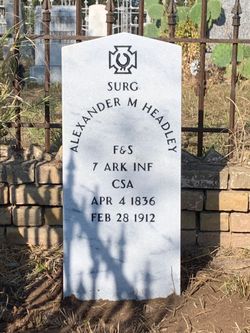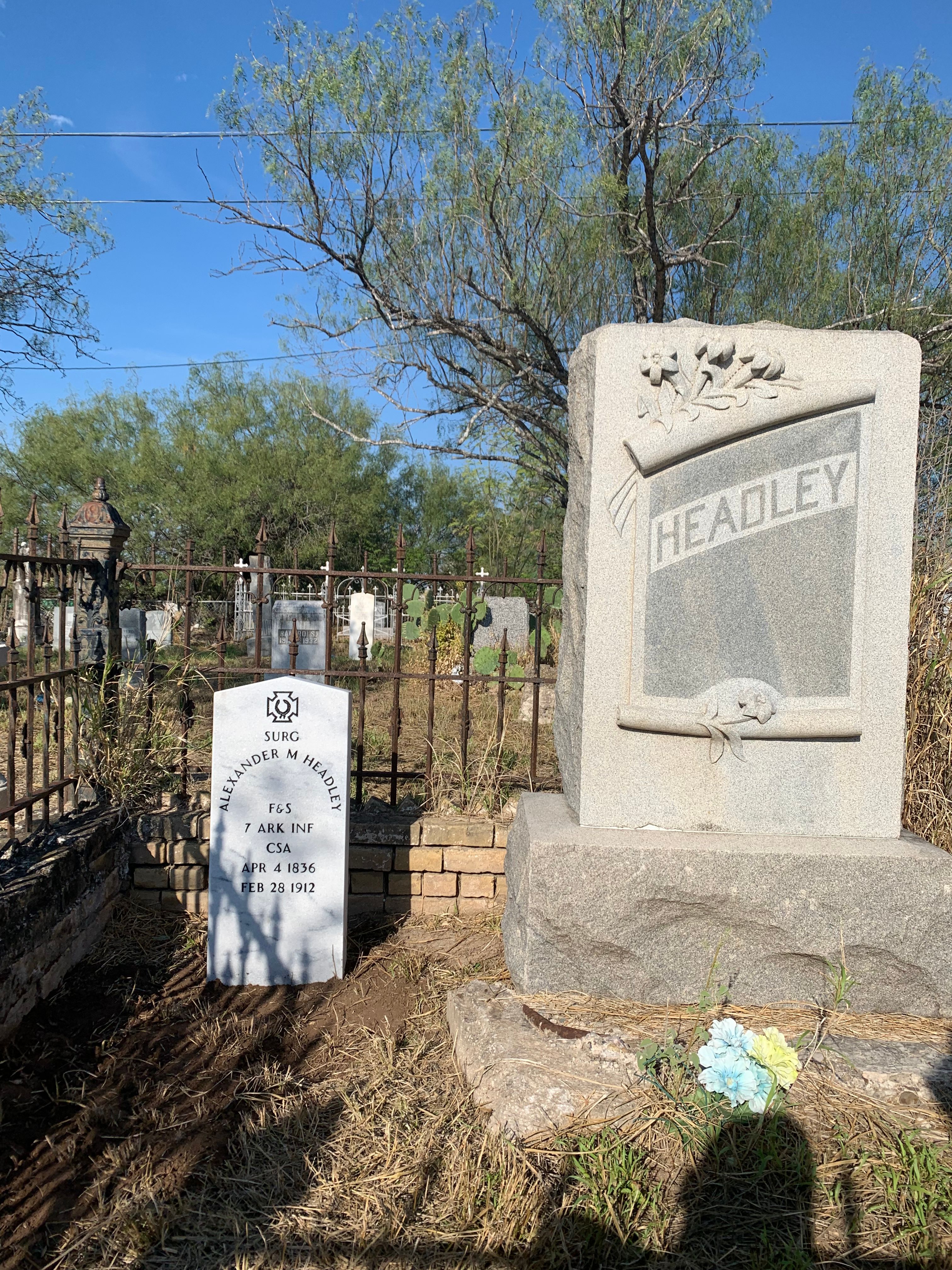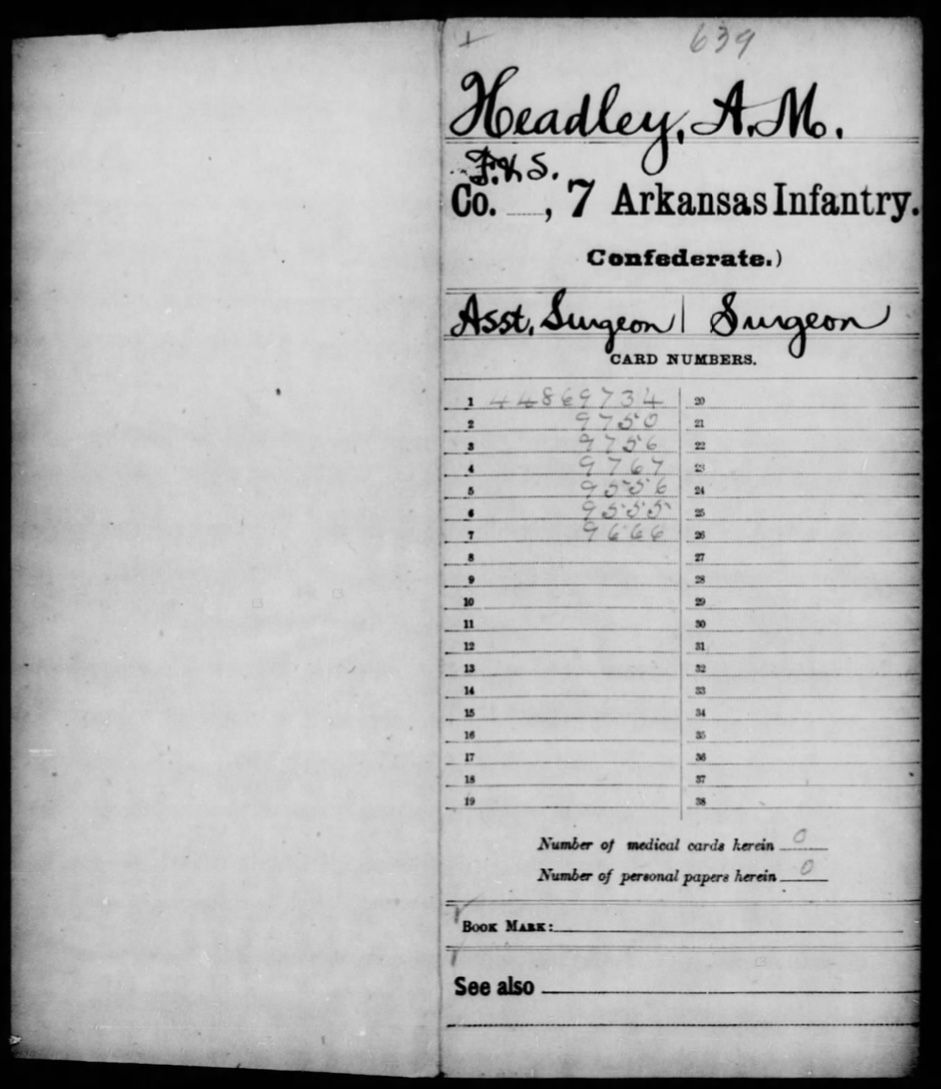After a brief stay in Mexico City and Córdoba, Vera Cruz, Headley moved north to Camargo, opposite Rio Grande City, Texas. There he established his medical practice and a large mercantile business called Casa de Comercio in early 1866. He was later appointed military commandant of Camargo by Lerdo de Tejada, who succeeded Benito Juárezqv as president of Mexico. During his service, in November 1875, Texas Ranger captain Leander McNelly crossed into Mexico, killed a number of Mexican citizens, and then retreated to the south bank of the Rio Grande when threatened by Mexican militia. Headley sought a truce under a white flag to investigate.
He married Pilar Treviño, age twenty-eight, his fourth and last wife, in Camargo in 1884, and they had a daughter. He regained United States citizenship in 1880 but continued to practice medicine on both sides of the river. During the epidemic of 1882–83 he treated many cases of yellow fever in Camargo. In Hidalgo County he joined the Republican Party and was county commissioner of Precinct 3 in 1890. Contending the Republicans had won an election, Headley led an armed attack on the courthouse at Edinburg (now Hidalgo), evicted the Democrats, who fled to Reynosa, Mexico, and tried to establish his own government. Governor John Ireland dispatched sixty rangers to arrest Headley, but they encountered Headley's forces on guard and surrendered the warrant. In a separate incident, also part of the current political turmoil, the wife of H. T. McCabe, friend and political ally of Headley, shot and killed Hidalgo county judge Max Stein in Reynosa. She was arrested and sent to Matamoros, where Headley rescued her from the police station and escaped to the United States. About a mile from his ranch, Headley was served black coffee laced with arsenic by one of his men. He immediately rode to the ranch, swallowed a bottle of castor oil, and survived. He sold his ranch, moved to Rio Grande City, and continued to practice medicine and lead the Republicans there until his death in February 1912.
BIBLIOGRAPHY: Evan Anders, Boss Rule in South Texas: The Progressive Era (Austin: University of Texas Press, 1982). George Durham, Taming the Nueces Strip: The Story of McNelly's Rangers (Austin: University of Texas Press, 1962). Napoleon Augustus Jennings, A Texas Ranger (New York: Scribner, 1899; rev. ed., Austin and Dallas: Graphic Ideas, 1972). Daniel O'Flaherty, General Jo Shelby (Chapel Hill: University of North Carolina Press, 1954). Brian Robertson, Wild Horse Desert: The Heritage of South Texas (Edinburg, Texas: Hidalgo County Historical Museum, 1985). San Antonio Express, August 22, 1909. Walter Prescott Webb, The Texas Rangers (Boston: Houghton Mifflin, 1935; rpt., Austin: University of Texas Press, 1982).
George H. Edgerton
After a brief stay in Mexico City and Córdoba, Vera Cruz, Headley moved north to Camargo, opposite Rio Grande City, Texas. There he established his medical practice and a large mercantile business called Casa de Comercio in early 1866. He was later appointed military commandant of Camargo by Lerdo de Tejada, who succeeded Benito Juárezqv as president of Mexico. During his service, in November 1875, Texas Ranger captain Leander McNelly crossed into Mexico, killed a number of Mexican citizens, and then retreated to the south bank of the Rio Grande when threatened by Mexican militia. Headley sought a truce under a white flag to investigate.
He married Pilar Treviño, age twenty-eight, his fourth and last wife, in Camargo in 1884, and they had a daughter. He regained United States citizenship in 1880 but continued to practice medicine on both sides of the river. During the epidemic of 1882–83 he treated many cases of yellow fever in Camargo. In Hidalgo County he joined the Republican Party and was county commissioner of Precinct 3 in 1890. Contending the Republicans had won an election, Headley led an armed attack on the courthouse at Edinburg (now Hidalgo), evicted the Democrats, who fled to Reynosa, Mexico, and tried to establish his own government. Governor John Ireland dispatched sixty rangers to arrest Headley, but they encountered Headley's forces on guard and surrendered the warrant. In a separate incident, also part of the current political turmoil, the wife of H. T. McCabe, friend and political ally of Headley, shot and killed Hidalgo county judge Max Stein in Reynosa. She was arrested and sent to Matamoros, where Headley rescued her from the police station and escaped to the United States. About a mile from his ranch, Headley was served black coffee laced with arsenic by one of his men. He immediately rode to the ranch, swallowed a bottle of castor oil, and survived. He sold his ranch, moved to Rio Grande City, and continued to practice medicine and lead the Republicans there until his death in February 1912.
BIBLIOGRAPHY: Evan Anders, Boss Rule in South Texas: The Progressive Era (Austin: University of Texas Press, 1982). George Durham, Taming the Nueces Strip: The Story of McNelly's Rangers (Austin: University of Texas Press, 1962). Napoleon Augustus Jennings, A Texas Ranger (New York: Scribner, 1899; rev. ed., Austin and Dallas: Graphic Ideas, 1972). Daniel O'Flaherty, General Jo Shelby (Chapel Hill: University of North Carolina Press, 1954). Brian Robertson, Wild Horse Desert: The Heritage of South Texas (Edinburg, Texas: Hidalgo County Historical Museum, 1985). San Antonio Express, August 22, 1909. Walter Prescott Webb, The Texas Rangers (Boston: Houghton Mifflin, 1935; rpt., Austin: University of Texas Press, 1982).
George H. Edgerton
Family Members
Sponsored by Ancestry
Advertisement
Advertisement










